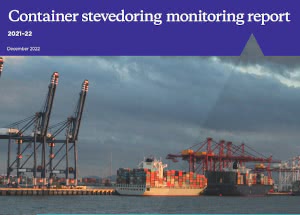
If different antitrust and regulatory authorities World are evaluating the work of the main companies of Global containerized navigation to verify that it has been complies with competition rules over the last three years characterized by the global spread of the pandemic of Covid-19 and the consequent effects on mobility, The Australian Competition & Consumer Commission (ACCC) has analyzed the behavior in the same period of terminal operators dockers operating in the container segment, companies that represent the crucial node that connects the maritime supply chain Contianerized with the terrestrial supply chains of markets.
 The "Container Stevedoring Monitoring Report" 2021-22", released today by the Antitrust Authority Australian, highlights that the value of the operating margin of the Australian port terminal companies operating in the container segment increased by 14 points percentages since the beginning of the coronavirus pandemic reaching The highest level since about ten years ago is ended the duopoly formed by the Australian Patrick Terminals and the Emirati DP World who dominated this sector. In the only Financial year 2021-22, ended last June 30, the margin of operating profit of the top five terminal operators Australians operating in this segment was 24% compared to 10% in the 2019-20 financial year. The analysis notes that between 2000 and 2013 Patrick and DP World as well as the container Adelaide terminal had realized overall margins operational between 21% and 27%, but - the document specifies - in the seven years following the competition introduced by Hutchison Ports Australia of the Hutchison Port Holdings group and Victorian International Container Terminal of the ICTSI group, together with Substantial infrastructure investments and other developments, had led to a decline in their margins.
The "Container Stevedoring Monitoring Report" 2021-22", released today by the Antitrust Authority Australian, highlights that the value of the operating margin of the Australian port terminal companies operating in the container segment increased by 14 points percentages since the beginning of the coronavirus pandemic reaching The highest level since about ten years ago is ended the duopoly formed by the Australian Patrick Terminals and the Emirati DP World who dominated this sector. In the only Financial year 2021-22, ended last June 30, the margin of operating profit of the top five terminal operators Australians operating in this segment was 24% compared to 10% in the 2019-20 financial year. The analysis notes that between 2000 and 2013 Patrick and DP World as well as the container Adelaide terminal had realized overall margins operational between 21% and 27%, but - the document specifies - in the seven years following the competition introduced by Hutchison Ports Australia of the Hutchison Port Holdings group and Victorian International Container Terminal of the ICTSI group, together with Substantial infrastructure investments and other developments, had led to a decline in their margins.
The report notes that in the year 2021-22 the supply chain dysfunctions that have impacted ports Australians in terms of unreliability of arrival dates of ships and an increase in the size of vessels which have Scaled national ports, impact exacerbated by the lack of labor throughout the sypply chain, and specifies that the largest costs incurred by the owners of the goods due to the high Levels of sea freight and other costs for the use of the supply chain, have been passed on to consumers Australians through rising prices of goods imports, which has caused the recent increase in inflation in Australia.
In this regard, the analysis shows that some navigation have imposed extra-costs for delayed return of containers by cargo owners who could not return the container on time due to delays to which they have contributed the same shipping companies. Additional costs that have been put under scrutiny in several countries, including the USA, and with respect to which, as well as other expenses that may be unreasonably charged to them, the Australian owners of the goods according to the ACCC are not adequately protected.
"Several years ago - commented Anna Brakey, commissioner of the ACCC - importers and exporters benefited from an injection of new competition in our ports, but we are Concerned that in recent years these benefits have been have been eroded to the detriment of importers and exporters and, ultimately, analysis, of Australian consumers'.
The Australian antitrust authority has specified that it has not yet formulated a conclusive hypothesis on which were the main responsible for the recent increases in operating profits of port terminalists, also because the relevant limitation of containerized sea transport capacity which has characterized the period of the pandemic has made more It is difficult for importers and exporters to avail themselves of a maritime service rather than another, and therefore of a different terminal operator, which may have had a weakening of competition in relation to tariffs charged by terminal operators. "If the greatest profits of terminal operators are due to recent shocks to the transport supply chain global containerized - Brakey observed - we would expect that Over time, profits decrease as congestion Sea and terminal transport is reduced. In the coming years We will carefully examine financial charges and performance terminal operators to see if there are structural factors or behaviors that produce higher profits and if Further policy or regulatory responses are warranted."